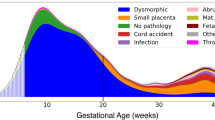Abstract
Purpose
To identify predictive ultrasound signs for unfavorable outcome in fetal gastroschisis (GS).
Methods
This is a retrospective cohort study among pregnant women with the prenatal diagnosis of GS between 1998 and 2011 at the University of Wuerzburg, Germany. Analysis included prenatal ultrasound scans, neonatal intensive care unit (NICU) records, and pediatric records. The collected variables included maternal and fetal demographics, as well as an analysis of predictors for unfavorable fetal outcome. Unfavorable outcome was defined by more than 2 postnatal surgical interventions, intestinal resections, and long time to oral feeding (≥4 weeks).
Results
35 cases of fetal GS were diagnosed, whereby 23 cases met the inclusion criteria and were evaluated by prenatal ultrasound and postnatal outcome. Based on the postnatal situation, 15 patients were classified in a good prognosis group and 8 patients in a poor prognosis group. Fetuses with poor prognosis were presented later during pregnancy (21.1 ± 6 vs. 26.9 ± 5.3 weeks; p < 0.01) and delivered at earlier gestational age (35.6 ± 0.8 vs. 33.4 ± 1.4 weeks; p < 0.01) with lower birth weight (2074 ± 306.3 vs. 2559 ± 255.4 g; p < 0.01). There were no differences in prenatal findings like growth restriction, amniotic fluid index, or Doppler results between good and poor prognosis group. However, early detected and long-lasting bowel dilatation was associated with poor prognosis.
Conclusion
Late presentation and early gestational age at delivery are associated with poor prognosis in neonates with GS. Furthermore, early onset as well as long duration of bowel dilatation is associated with poor fetal outcome, while other ultrasound characteristics are not able to predict poor prognosis of GS.


Similar content being viewed by others
References
Loane M et al (2007) Increasing prevalence of gastroschisis in Europe 1980–2002: a phenomenon restricted to younger mothers? Paediatr Perinat Epidemiol 21(4):363–369
David AL, Tan A, Curry J (2008) Gastroschisis: sonographic diagnosis, associations, management and outcome. Prenat Diagn 28(7):633–644
Torfs CP et al (1998) Association between mothers’ nutrient intake and their offspring’s risk of gastroschisis. Teratology 58(6):241–250
Goldbaum G, Daling J, Milham S (1990) Risk factors for gastroschisis. Teratology 42(4):397–403
Torfs CP et al (1994) A population-based study of gastroschisis: demographic, pregnancy, and lifestyle risk factors. Teratology 50(1):44–53
Schulz AC et al (2012) A classic twin study of isolated gastroschisis. Fetal Pediatr Pathol 31(5):324–330
Garne E et al (2007) Gastrointestinal malformations: impact of prenatal diagnosis on gestational age at birth. Paediatr Perinat Epidemiol 21(4):370–375
Orion KC et al (2011) Outcomes of plastic closure in gastroschisis. Surgery 150(2):177–185
Bradnock TJ et al (2011) Gastroschisis: one year outcomes from national cohort study. BMJ 343:d6749
Mastroiacovo P et al (2007) Gastroschisis and associated defects: an international study. Am J Med Genet A 143A(7):660–671
Ruano R et al (2011) The association of gastroschisis with other congenital anomalies: how important is it? Prenat Diagn 31(4):347–350
Overcash RT et al (2014) Factors associated with gastroschisis outcomes. Obstet Gynecol 124(3):551–557
Aina-Mumuney AJ et al (2004) A dilated fetal stomach predicts a complicated postnatal course in cases of prenatally diagnosed gastroschisis. Am J Obstet Gynecol 190(5):1326–1330
Santiago-Munoz PC et al (2007) Outcomes of pregnancies with fetal gastroschisis. Obstet Gynecol 110(3):663–668
Nick AM et al (2006) Second-trimester intra-abdominal bowel dilation in fetuses with gastroschisis predicts neonatal bowel atresia. Ultrasound Obstet Gynecol 28(6):821–825
Puligandla PS et al (2004) The significance of intrauterine growth restriction is different from prematurity for the outcome of infants with gastroschisis. J Pediatr Surg 39(8):1200–1204
Cain MA et al (2014) Perinatal outcomes and hospital costs in gastroschisis based on gestational age at delivery. Obstet Gynecol 124(3):543–550
Author information
Authors and Affiliations
Corresponding author
Ethics declarations
Conflict of interest
The authors declare that there is no potential conflict of interest.
Rights and permissions
About this article
Cite this article
Stüber, T.N., Frieauff, E., Weiß, C. et al. Prenatal sonographic ultrasound predictors for the outcome in fetal gastroschisis: a retrospective analysis. Arch Gynecol Obstet 293, 1001–1006 (2016). https://doi.org/10.1007/s00404-015-3936-2
Received:
Accepted:
Published:
Issue Date:
DOI: https://doi.org/10.1007/s00404-015-3936-2




